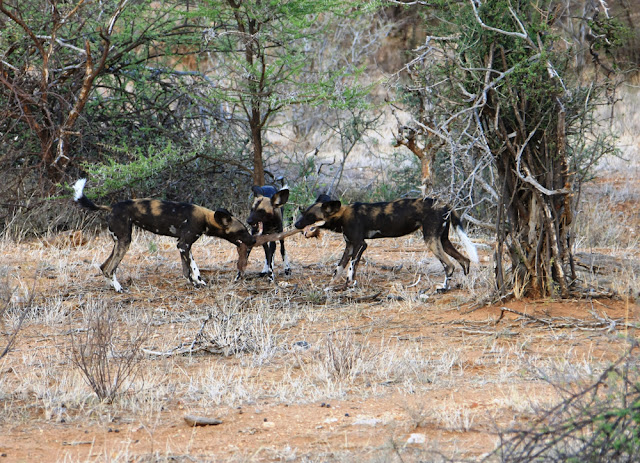As we crossed a small creek opposite Serena Lodge, we came across a pack of the African wild dogs, one of the most endangered canine species in Africa. The African wild dog has a unique way of hunting. The pack will chase the prey until it is exhausted.
Within seconds, the pack had brought down a male dik dik….and all fought to have a piece of the meat.
Soon after feasting on the dik dik, the pack of 14 climbed a hill to rest.
Facts on the African Wild Dog
The African wild dog is also called the 'Cape hunting dog' or 'painted dog'. The dog's Latin name means "painted wolf," referring to the animal's irregular, mottled coat. Each animal has a unique coat pattern, and all have big, rounded ears.
It typically roams the open plains and sparse woodlands of sub-Saharan Africa. These long-legged canines have only four toes per foot, unlike other dogs, which have five toes on their forefeet.
African wild dogs live in packs that are usually dominated by a monogamous breeding pair.The female has a litter of two to 20 pups, which are cared for by the entire pack. These dogs are very social, and packs have been known to share food. They also help weak or ill members. Social interactions are common, and the dogs communicate by touch, actions, and vocalizations.
African wild dogs hunt in formidable, packs of six to 20 (or more) animals. Larger packs were more common before the dogs became endangered. Packs hunt antelopes and will also tackle much larger prey, such as wildebeests, particularly if their quarry is ill or injured. The dogs supplement their diet with rodents and birds.
As human settlements expand, the dogs have develop a taste for livestock, though significant damage is rare. Unfortunately, the dogs are often hunted and killed by farmers in revenge for killing their livestock.
African hunting dogs are endangered. They are faced with habitat loss and are also susceptible to diseases spread by domestic animals.
Unique creatures seen on a game drive
Gerenuks, derived from the Samburu name meaning 'giraffe antelopes' browse in the morning and evening. The gerenuk is one of the 'special five' of Samburu - the others are the Somali ostrich, reticulated giraffe, Grevy's zebra and Beisa's oryx.
They stand on their hind legs to reach the shrubs.
These antelopes live in herds of six to 10 animals with one territorial male and females.
Orange breasted parrot. beautiful ain't he?
Bush Buck.
Vulturine guine-fowl - only found in northern Kenya
The desert rose - pretty but poisonous.
We came across this fella near Samburu Intrepids. He was about 2 and a half metres long!
Menacing look.
Cheetah hunt caught on camera!
North of Samburu Lodge we saw a cheetah and her two cubs. We followed them patiently as they looked a bit hungry, and our hunch was rewarded pretty soon - a hunt was just about to begin!
Target in sight - a dik dik (this is one of the smallest antelopes, found only in the northern parts of Kenya).
The dik dik tried its best to flee for safety but in vain - he didn't stand a chance. Out flanked, out run and over powered by the fastest predator on land, the battle was over before it begun! The mother cheetah was also using the dik dik to train her cubs how to hunt because as soon as they are adults they have to hunt on their own. She also ate last, maybe recognising that they were tired and she - matrimonially - was still looking out for them.
Fun facts about dik diks:
Habitat: Dik diks live mostly in semi arid regions with low bush along dry, rocky stream beds
Behavior: Dik diks form monogamous pairs in that reside in fixed territories. They mark their territory with dung deposits and with secretions from the preorbital gland.
Sight, scent and hearing are well-developed and they are very alert.
They respond to the alarm calls of other animals. When in danger they hide.
Report by Francis Lenyakopiro, Culturalist / Naturalist at Samburu Intrepids Club. Pictures by Francis Lenyakopiro, Barbara Minishi and Ndeithi Kariuki.

















No comments:
Post a Comment